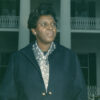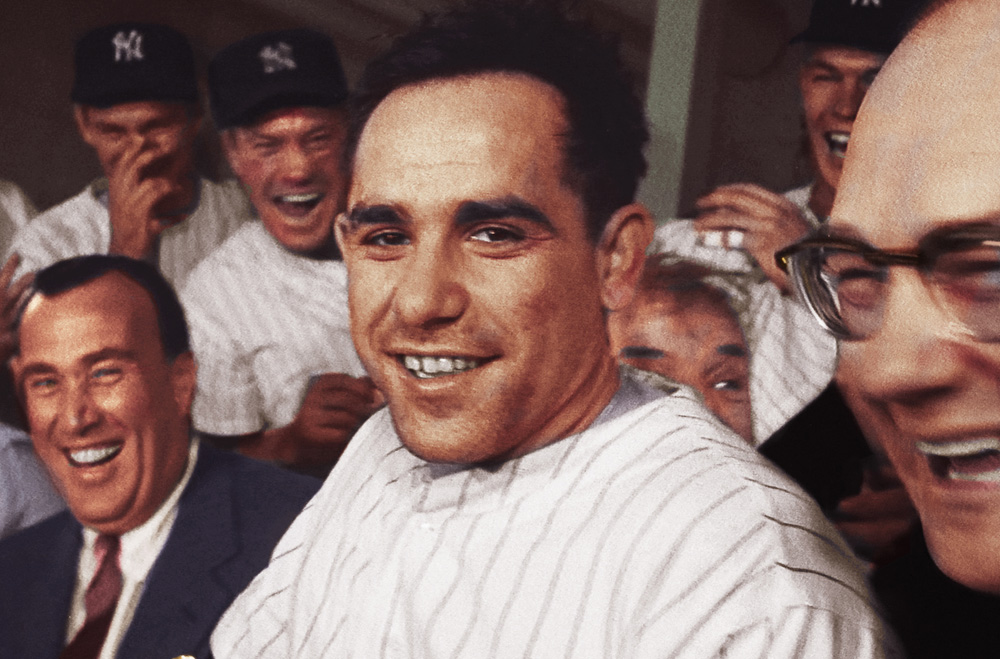Of the many ways that Yogi Berra was one of a kind, it may be one of the most unusual that he became one of the most memorable players in baseball history, but not necessarily for what he did in the sport itself. Calling it like he saw it as a catcher for the greatest stretch in New York Yankees history and off the field as well where his colloquial wisdom known as “Yogisms” continue to reverberate, Berra strangely doesn’t always make it into conversations about the greatest that ever lived in spite of a stat line that ranks among the sport’s best and his 10 World Series rings that bridged the Bronx bombers’ runs between the Joe DiMaggio era and the dawn of Mickey Mantle. While Berra had a way with words, he was the last one to speak up for himself when it came to individual plaudits, a team captain not because he would boast about his talent but make everyone around him better, so the new biography “It Ain’t Over” offers something of a corrective, engaging Yankess past and present such as Joe Torre, Derek Jeter, Don Mattingly, Willie Randolph and Mariano Rivera to speak to someone who made them feel more honored than any other to put on the pinstripes themselves.
However, director Sean Mullin makes a convincing case beyond Berra’s greatness as a player for his greatness as a man, someone who volunteered to put his baseball career on hold to serve in World War II, welcomed the first Black players in Jackie Robinson and Larry Doby into the league with open arms and never failed to carve out time for his family, writing letters from the road to his wife Carm and managing to have a family life when he’d strategize as well as he would for a game. It clearly instilled a fierce devotion to protect his legacy amongst his brood, particularly his granddaughter Lindsay, who takes up the crusade to see Berra recognized for his on-field accomplishments and becomes a driving force for “It Ain’t Over,” serving as a narrator who shows a gift for gab runs in the blood. Although at 5’7”, Berra was thought to be miscast as a Major Leaguer, “It Ain’t Over” argues that his stature only grown in the years following an illustrious career and still looms large over the game today. With the film in theaters this week after a triumphant premiere last summer at Tribeca, Mullin spoke about letting both Berra’s personality and his many achievements shine in a film as spirited as its star, elevating the archival action to feel contemporary and how he drew on his own biography to know what was worthy of celebration in Berra’s life.
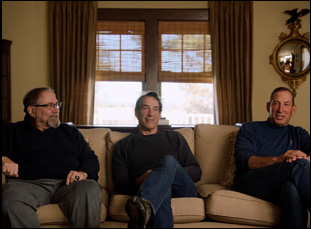
I was approached by Peter and Mike Sobiloff, some producers I worked with in the past that asked me if I’d be interested in doing a doc about Yogi Berra. This was in 2018, and my initial reaction was like, “Geez, I don’t know. Is he too perfect of a person? What’s the drama?” And then I ended up just falling in love with him and after I did my research, I [thought], this is a person we can really get an audience behind.
That’s intriguing to me because a central conflict of the film itself seems to be making the case of greatness for a person who would be too humble to make that case for himself. Was that interesting to grapple with?
Maybe he wouldn’t have liked the film. I don’t know. The family says he would have, so I’m going to go ahead and go there, but he was definitely was not boastful at all, and we just were trying to set the record straight. Essentially, we just felt his personality ended up overtaking his stature as a ballplayer.
Was the family involved from the start?
They were — the very first meeting I had about this was with Larry, Tim, and Dale, the three sons and we sat down in their lawyer’s office, and pitched them this idea. I was there with Peter and Mike Sobiloff, and I laid out my vision for the film and they took a liking to me fortunately. It took a while to get the money raised [because] nobody really thought much about Yogi, as far as the viability of having a movie about him, but we just started shooting and I met Lindsay along the way. Then the more I got to know Lindsay, the more I [thought] this is a force of nature who needs to be involved Into this project and as Lindsay got more and more involved as we went along, it eventually made [sense for] her to narrate the film.
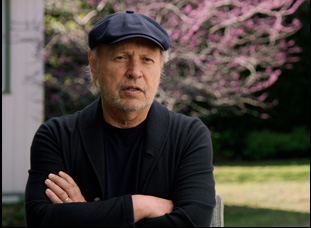
Yeah, Don Mattingly was actually shot at Citi Field before a Mets game, he was up there with the Marlins, and they all said yes, but scheduling them and and shooting was [challenge]. We have an amazing production company here in L.A., Vanishing Angle, Matt Miller and Natalie Metzger, who helped with all the logistics, but it was tough. COVID didn’t help at all – this was at the height of it, and Derek Jeter was at his offices down in Miami and Billy Crystal was in his backyard, so it took a while. This movie’s taken about five years from idea to theatrical release, but it’s been a labor of love. And I had to go back to where he grew up in the hill in the Italian section of St. Louis and I went to his childhood home — it’s now an Airbnb you can rent for like 65 bucks a night, but I had to meet… there’s a scene with the two nieces, you remember them?
I was actually going to bring this up — when you go to the shoot with the nieces, do you know what they’re gonna wear, or were their matching Yogi t-shirts a complete surprise?
Yeah, no, total surprise. I don’t think they ever take those things off.
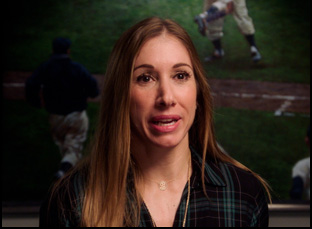
Yeah, this is only my second documentary, so I’m still kind of new at them, but I’m proud of how it turned out. We were able to really tell an interesting story here, and with documentaries, you have so many weapons at your disposal, so I was able to really lean into some of that archival and verite, and even some animation graphics to really help get the point across. It was a really fun way to tell a story. My editor Julian Robinson is an incredible filmmaker and a real genius, and being able to cut these things together in a way that put the audience viscerally in these games as much as we could was tough because there weren’t a lot of close-up cameras back then. The cameras were super high and wide, so we had to really get creative with our editing.
The sequence that I really wanted to hone in on was how you show his hitting mechanics – you understand that it was both different from others, but worked in such a unique way. Was that difficult to put together?
Yeah, that was particularly hard because we didn’t have much footage of him hitting up close — it was all so far away, but we tried to show his hands, and the way he was a bad ball hitter. That’s what [everyone] kept saying about him, and explaining that to a non-baseball audience [was tricky], but that was really important for this film. I did not want to make a baseball movie at all. I just wanted to make just a story about a life well lived so by 30 minutes into the movie, baseball’s done and to me, the aspect of the film that sticks out the most is that love story between him and Carm. It’s just beautiful and loving, and those love letters he wrote to her were so great. Just the fact that they had each other’s back for so many years and it’s just a beautiful, beautiful story and when I started this, I didn’t think the love story was going to be as big a part of the film as it was, but to me, it’s the emotional core of the film.
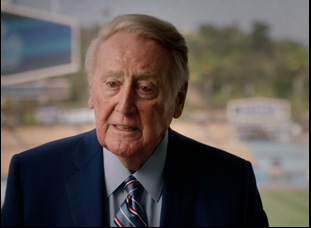
Absolutely. I was in the New York National Guard starting the summer of ’99, so when the towers were hit on September 11th, I was in my uniform by noon and I ended up serving as a first responder down at Ground Zero and [became] the officer in charge of the soldiers at Ground Zero for the better part of the next nine months, so, obviously, I went through some trauma, especially those first two weeks of cordoning off the area and doing all the things you have to do to be a first responder, and knowing that Yogi was in Normandy on D-Day, and tasked with pulling bodies out of the water the day after, there was no way I was going to leave that out. I wanted to make sure we made a meal of that and let people know that, yes, he was an incredible person, and yes, he was an incredible ballplayer, but the things he went through really grounded him and laid a really nice foundation for the rest of his life in a good way.
Even though they were involved throughout, what was it like showing this to the family for the first time?
We premiered at Tribeca with a thousand-seat theater sold out and all that, but the thing that really made me most anxious was the very first time I sent the link of the cut, before we locked the picture, over to Lindsey and her father Larry. I ended up pacing around all night waiting for them to watch it and whey called me, they said it was a gift to the family. That was the review that meant the most to me.
“It Ain’t Over” opens on May 12th. A full list of theaters and cities is here.



